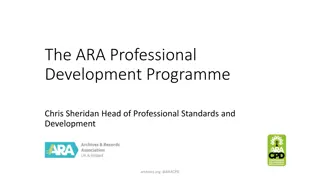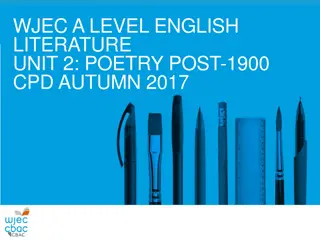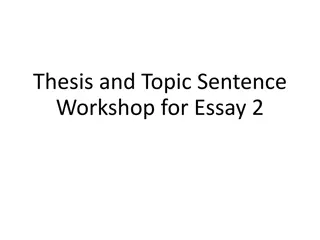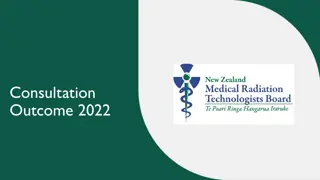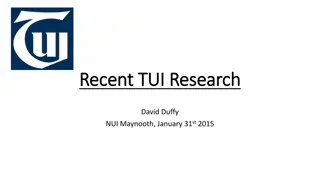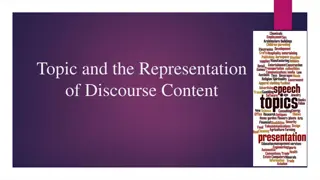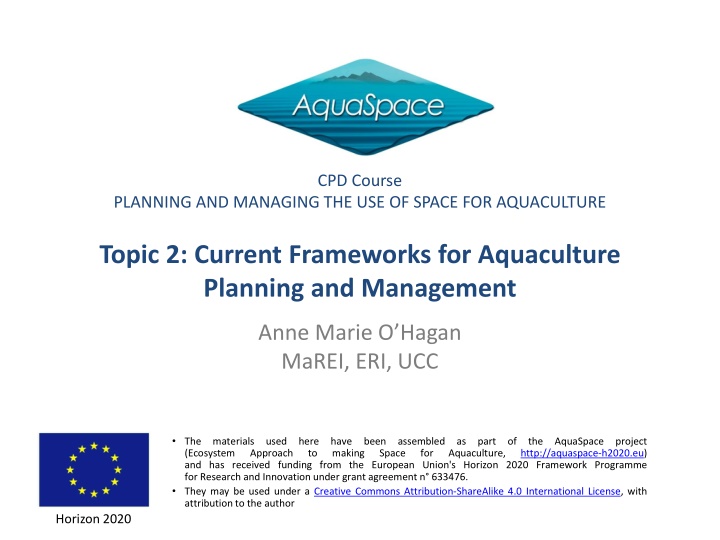
Managing Aquaculture Space: Legal Frameworks and Competencies
Explore the legal frameworks and competencies governing aquaculture planning and management in the EU. Learn about key EU laws, principles, and areas of competence related to sustainable development, environmental protection, and more.
Download Presentation

Please find below an Image/Link to download the presentation.
The content on the website is provided AS IS for your information and personal use only. It may not be sold, licensed, or shared on other websites without obtaining consent from the author. If you encounter any issues during the download, it is possible that the publisher has removed the file from their server.
You are allowed to download the files provided on this website for personal or commercial use, subject to the condition that they are used lawfully. All files are the property of their respective owners.
The content on the website is provided AS IS for your information and personal use only. It may not be sold, licensed, or shared on other websites without obtaining consent from the author.
E N D
Presentation Transcript
CPD Course PLANNING AND MANAGING THE USE OF SPACE FOR AQUACULTURE Topic 2: Current Frameworks for Aquaculture Planning and Management Anne Marie O Hagan MaREI, ERI, UCC The (Ecosystem and has received funding from the European Union's Horizon 2020 Framework Programme for Research and Innovationunder grant agreementn 633476. They may be used under a Creative Commons Attribution-ShareAlike 4.0 International License, with attributionto the author materials used here to have making been assembled Space as part of the AquaSpace project Approach for Aquaculture, http://aquaspace-h2020.eu) Horizon 2020
Overview Legal basis for EU law on environment, fisheries and aquaculture Key EU legal instruments for marine / coastal management Conservation Impact assessment processes
EU Legal basis Article 3(3) TEU defines the objectives of the EU: The Union shall work for sustainable development of Europe based on balanced economic growth and price stability ( ) and a high level of protection and improvement of the quality of the environment Art. 191 TFEU: defines objectives and principles of EU environmental policy (+ new legal basis for climate change and Art. 194 sets a new legal basis for EU energy policy) Transboundary effects in third countries: international treaties/agreements
Legal Principles Article 5 TEU defines general principles/mechanisms of EU law: Proportionality Subsidiarity Article 191(2) TFEU defines environmental principles: Union policy on the environment shall aim at high level of protection taking into account the diversity of situations in the various regions of the Union. It shall be based on the precautionaryprinciple and on the principles that preventive action should be taken, that environmental damage should as a priority be rectified at source and that the polluter should pay
Areas of Competence Shared Competence support, coordinate or supplement MS action Exclusive Competence Competence to Competence to provide arrangements within which EU member states must coordinate policy Conservation of marine biological resources under Common Fisheries Policy Agriculture and fisheries, excluding the conservation of marine biological resources Human health Economic policy Industry Social policies Culture Employment Economic, social and territorial cohesion Concluding international agreements Tourism Education & training Environment Non-exhaustive Civil protection Energy Administrative cooperation Research, Tech. dev.
EU Directives Over 200 relevant to the marine environment Horizontal (Cross cutting) Environmental Assessment; Environmental Justice and Information Sectoral Bathing water quality (revisions), Shellfish water (revisions), Waste water treatment, Nitrates, Water Framework Directive Marine Strategy Framework Directive Birds Directive, Habitats Directives Floods Directive Maritime Spatial Planning Directive
Integrated Maritime Policy All matters relating to Europe's oceans and seas are interlinked, and that sea-related policies must develop in a joined-up way if we are to reap the desired results Cross-cutting policies: Sea-basin strategies Blue Growth Marine data and knowledge Maritime Spatial Planning Integrated maritime surveillance
Marine Strategy Framework Directive (2008/56/EC) [1] Establishes a framework within which Member States take measures to achieve or maintain Good Environmental Status in the marine environment by 2020 First attempt at an Ecosystems-based Approach Applies to marine waters from baseline to 200M First EU legal instrument with an objective to maintain marine biodiversity Implementation on a Regional basis: Marine Strategies Integrated the concepts of environmental protection and sustainable use
MSFD Regional Implementation [3] Four European marine regions Baltic Sea, North-east Atlantic Ocean, Mediterranean Sea and Black Sea
MSFD - Descriptors [4] 1. 2. 3. 4. Biodiversity is maintained Non-indigenous species do not adversely alter the ecosystem The population of commercial fish species is healthy Elements of food webs ensure long-term abundance and reproduction Eutrophication is minimised The sea floor integrity ensures functioning of the ecosystem Permanent alteration of hydrographical conditions does not adversely affect the ecosystem Concentrations of contaminants give no effects Contaminants in seafood are below safe levels 10. Marine litter does not cause harm 11. Introduction of energy (including underwater noise) does not adversely affect the ecosystem 5. 6. 7. 8. 9.
Water Framework Directive [1] Objectives: Protection of aquatic ecosystems; Promotion of sustainable water use based on a long- term protection of available water resources; Improvement of the aquatic environment through specific measures for the progressive reduction of discharges, emissions and losses of priority substances and the cessation or phasing-out of discharges, emissions and losses of the priority hazardous substances; Reduction of pollution of groundwater, and, Mitigation of the effects of floods and droughts.
Water Framework Directive [2] Aim is to prevent the deterioration of ecological quality and the restoration of polluted surface and groundwaters by the end of 2015 Implemented through River Basin Management Plans River basins which cross national frontiers must be assigned to an international River Basin District (RBD) Addresses inland surface waters, estuarine and coastal waters and groundwater.
Water Framework Directive [3] Transitional waters = estuarine waters, precise technical details for characterisation set out in Annex II; Coastal waters defined as surface water on the landward side of a line, every point of which is at a distance of one nautical mile on the seaward side from the nearest point of the baseline from which the breadth of territorial waters is measured, extending where appropriate up to the outer limit of transitional waters. Note definition of coastal waters How will this align with MSFD and MSP? Local specificity?
Coastal waters must be assigned to the nearest or most appropriate river basin district or districts; Member States are obliged to appoint an authority responsible for applying the rules of the Directive within each RBD.
Common Fisheries Policy [1] Four main pillars 1. Fisheries Management e.g. Technical Conservation Measures, Total Allowable Catch (TACs) 2. Structural Policy: funds for infrastructure and fleet (e.g. EMFF) 3. Market and Trade Policy: consumer information (labelling), pricing, 4. External Policy: international agreements, access to waters Also separate rules on Aquaculture and Stakeholder Involvement (Advisory Councils)
Common Fisheries Policy [2] Reform package sought to boost aquaculture production EC published the Strategic Guidelines for the sustainable development of EU aquaculture (2013) Four priority areas identified: Reduce administrative burdens Improve access to space and water Increase competitiveness Exploit competitive advantages due to high quality, health and environmental standards Member States requested to produce Multi-annual National Strategic Plans to promote aquaculture 27 Plans produced
EU Strategic Guidelines on Aquaculture [1] Multi-annual National Strategic Plans Challenges identified at MS level Marine: Lack of available space in inshore, sheltered waters Complex administrative procedures Competitiveness of products Use of Research & Development outputs Environmental conditions Member States encouraged to define their own national targets based on their: Current positions, National circumstances and Institutional arrangements. Four priority areas: 1. Administrative procedures 2. Coordinated spatial planning 3. Competitiveness and 4. A level playing field Freshwater: Credit, investments and costs Fragmented structure of sector Lack of available space
EU Strategic Guidelines on Aquaculture [2] Exercise Critique your National Strategic Plan for Aquaculture Possible considerations: Links to other regulatory frameworks Approaches to spatial planning Recommended tools? Environmental monitoring Mention of EAA Is their scope to include EAA in total/part? Barriers Opportunities
Impact Assessment Needs to answer: what the problem is, what the objectives to be pursued are, what the options are, what their possible impacts are and how the options compare. Must ensure the balanced assessment of economic, environmental and social impacts of proposals and avoid unintended and unexpected side effects.
Types of Impact Assessment SEA EIA Appropriate Assessment Strategic level Site level Natura 2000 site and its conservation objectives Takes place at early stages of decision- making cycle: aims to prevent impacts Takes place near the end of decision- making cycle: aims to minimise impacts Takes place early in the process (screening) Emphasis on meeting environmental objectives, maintaining natural systems Emphasis on mitigating and minimising impacts Emphasis on possible nature conservation implications of any plan or project on Natura 2000 site Broad perspective, lower level of detail Narrow perspective, high level of detail High level of detail specific to site
Strategic Environmental Assessment (SEA) Directive [1] Involves the systematic identification and evaluation of the impacts of a strategic action (e.g. a plan or programme) on the environment ALSO the effects of the environment on the PPs Operates inconjunction with the EIA Directive Still uncertainty around what plans and programmes are subject to SEA.... does apply across a wide range of sectors
SEA Directive [2] Prepare an Environmental Report - likely significant environmental effects are identified and evaluated Consult the public, environmental authorities and any MS affected on the ER and draft P/P Take account of the findings of the ER and the outcome of the consultations in deciding whether to adopt or modify the draft P/P Make known the decision on adoption of the P/P and how SEA influenced the outcome.
SEA Directive [3] Environmental Report Contains the likely significant effects on the environment of implementing the PP Reasonable alternatives Significant effects on the environment Issues and their interrelationships Environmental objectives How does the PP take conservation objectives in the area into account
Nature Conservation: Birds and Habitats Directives and Biodiversity Policy
Birds Directive (2009/147/EC) Seeks to protect, manage and regulate all bird species naturally living in the wild within the European territory of the Member States, including the eggs of these birds, their nests and their habitats 193 endangered species and sub-species Requirement to designate Special Protection Areas (SPAs) on land or at sea (Wetlands of particular importance) Requires the avoidance of pollution or deterioration of habitats generally, outside SPAs May require the prevention or control of activities on, near or in an area which is the habitat of a protected bird
Levels of Protection in Birds Directive Annex 1: 194 species and sub-species are particularly threatened. Member States must designate SPAs for their survival and all migratory bird species. Annex 2: 82 bird species can be hunted. Hunting periods are limited and forbidden when birds are at their most vulnerable Annex 3: generally, activities that directly threaten birds, are banned. With certain restrictions, Member States can allow some of these activities for the 26 species listed in this Annex. Annex 4: the Directive provides for the sustainable management of hunting but Member States must outlaw all forms of non-selective and large scale killing of birds, using the methods listed in this Annex. Annex 5: the Directive promotes research to underpin the protection, management and use of all species of birds covered by the Directive, which are listed in this annex.
Habitats Directive (92/43/EEC) Preamble to ensure the restoration and maintenance of natural habitats and species of Community interest at favourable conservation status. Objective: To contribute towards ensuring biodiversity through the conservation of natural habitats and of wild fauna and flora in the European territory of the Member States to which the EC Treaty applies (Art. 2(1)) Seeks to ensures the conservation of a wide range of rare, threatened or endemic animal and plant species 1000 animal and plant species 200 habitat types Requirement to designate Special Areas of Conservation (SACs) on land or at sea
Levels of Protection in Habitats Directive Annex II species (about 900): core areas of their habitat are designated as sites of Community importance (SCIs) and included in the Natura 2000 network. These sites must be managed in accordance with the ecological needs of the species. Annex IV species (over 400, including many Annex II species): a strict protection regime must be applied across their entire natural range within the EU, both within and outside Natura 2000 sites. Annex V species (over 90): Member States must ensure that their exploitation and taking in the wild is compatible with maintaining them in a Favourable Conservation Status.
Natura 2000 Network Largest coordinated network of protected areas in the world Aim is to ensure the long-term survival of Europe's most valuable and threatened species and habitats Not a system of strict nature reserves Management Plans may be drawn up for designated sites Duty on Member States to avoid deterioration of habitats and significant disturbance of species Also have to establish the standards to be applied to consideration of development proposals potentially threatening any sites
Impact of Designation Designation does not exclude all human activities Developments likely to have an adverse effect on a Natura 2000 site must be subject to an Appropriate Assessment in light of the site s conservation objectives Developments must have no significant effects on the integrity of a designated site considering the Site structure, Function and Conservation objectives.
Appropriate Assessment* Process * HRA in the UK
Environmental Impact Assessment Directive [1] Introduced in 1985 Amended in 1997, 2003 and 2009 Codified in 2011 Amended in 2014 Requires an assessment of the environmental impact of any project likely to have significant effects on the environment before consent can be granted Annex I Annex II Other Member States must be consulted about proposals that are likely to have a transboundary effects.
EIA Directive [2] Developer mayrequest the competent authority to say what should be covered by the EIA (scoping stage); Developer must provide information on the environmental impact (EIA report Annex IV); The environmental authorities and the public must be informed and consulted; The competent authority decides, taking into consideration the results of consultations; The public is informed of the decision afterwards and can challenge the decision before the courts.
EIA Directive [3] Environmental studies: baseline and impact analysis Consultation with statutory environmental authorities, other interested parties and the public Project preparation Notification to competent authority Submission of env. information to competent authority Consideration of environmental information by competent authority before making final decision Screening Review of adequacy of env. information Announcement of decision Scoping Post-decision monitoring if project is granted consent [Coloured stages are covered explicitly by Directive] Source: ERM, 2001
EIA Directive [4] What should an EIA do? What type of information should be included? Note changes in legislation (Directive and transposing instruments) What type of effects should be covered? How are cumulative impacts dealt with? How is monitoring dealt with?
Summary SEA EIA Takes place at earlier stages of decision- making cycle: aims to prevent impacts Takes place near the end of decision- making cycle: aims to minimise impacts Pro-active approach to development proposal Reactive approach to development proposal Considers broad range of potential alternatives Considers limited number of feasible alternatives Emphasis on meeting environmental objectives, maintaining natural systems Emphasis on mitigating and minimising impacts Broad perspective, lower level of detail to provide a vision and overall framework Narrow perspective, high level of detail
Differences between Assessments EIA AA Development type? All projects in Annex I, discretionary for Annex II projects. Any development likely to have an adverse effect on a Natura 2000 site. Impacts to be assessed? Direct and indirect, secondary, cumulative, short, medium and long- term, permanent and temporary, positive and negative significant effects. Assessment should be made in view of the site s conservation objectives (which are a function of the species/ habitat types for which the site was designated). Done by? The developer. The Competent Authority (with developer input). Outcomes? Results must be taken into consideration in the development consent procedure. Binding. Competent authorities can agree to the development only after having ascertained that it will not adversely affect the integrity of the site.
Suggested Exercise Facilitated discussion on current planning and management frameworks covering topics such as: Strategic aquaculture policy (presence/absence? SWOT Analysis of existing legal framework What impacts positively on the sector? What impedes development? Attention should be paid to whether these derive from international/EU/national law or administrative processes Theory v. practice How is monitoring dealt with? Enforcement and compliance aspects
For more information about the AquaSpace CPD Course and spatial planning toolbox, visit our website: www.aquaspace-h2020.eu The materials used here have been assembled as part of the AquaSpace project (Ecosystem Approach to making Space for Aquaculture, http://aquaspace-h2020.eu) and has received funding from the European Union's Horizon 2020 Framework Programme for Research and Innovation under grant agreement n 633476. Horizon 2020



